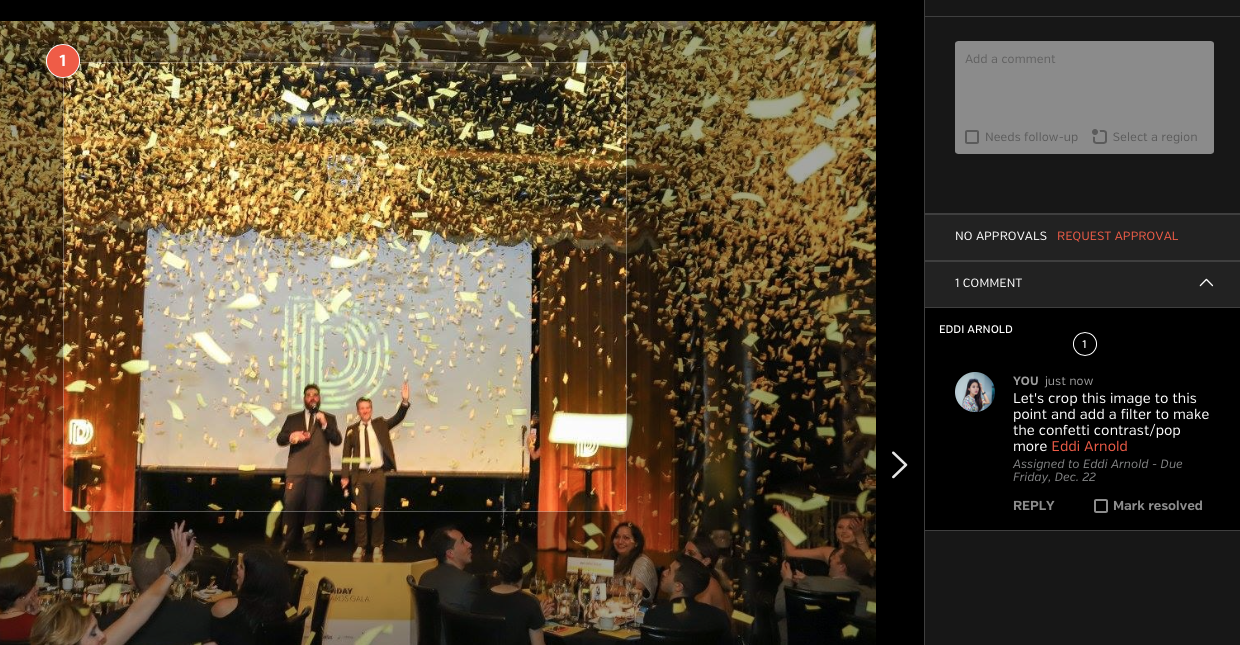It’s common practice for agencies and marketing teams to have a traditional project management solution (such as Asana, Basecamp or Trello) to handle job numbers, creative requests, tasks and deadlines (check, check and check). But, what happens when the work starts to be produced by the creative team? How do you keep feedback, files and design specific tasks in order when images need to be marked up outside of a project management system?
What’s a team to do?Trying to use a traditional project management tool for creative change orders didn’t work — it was time consuming and inefficient. We’d have to manually bullet out all of the changes separate from the creative and that left room for interpretation, and therefore, mistakes.
– Stacey DeOrzio / HZDG
We’ve spoken with a handful of creative agencies who recognized this issue and the inefficiencies they had been experiencing without a proper creative workflow in place to complement their project management system. They turned to Hightail – a visual project management & collaboration solution – to help manage the creative review cycles that happen within a project.
What is a Visual Project Management solution?We use Asana as the checklist for the production process, covering everything from itineraries to the shoot itself. Once the shots are in, I upload them to Hightail and share the link in Asana, so we can decide which images we’ll use.
– Tony Andrews / HUCK
OK, I’ll admit we may have thrown a new term out there, and if you’ve heard it before then it’s probably defined differently. We refer to our solution as visual project management because we use a creative-first approach. We do this in three key ways:
1 | Features are designed to be intuitive, simple and specifically for the creative process – which is focused on visuals. Traditional project management tools may be robust but often offer far more than what a creative team actually needs to get the job done, which introduces unwanted complexity.
2 | Assignments and progress is in reference to a creative file preview. For example, feedback is collected in context to the visual preview of a creative asset vs recorded for the team to read in a discussion thread.
3 | Creative teams gravitate towards software that is really, really ridiculously good looking. We’ve been told a time or two that our product is visually appealing, which helps with new process adoption.
Our solution allows managers to stay on top of progress without interrupting their creative team and keeps updates centered around the visual file. Want to know more about how visual project management could work for your creative team? First, if you haven’t already, sign up for a free 14-day trial of Hightail. Then, follow these steps.Kick off a Project
As a manager, you’ll want to make sure your entire team has access to the creative files being produced. Start a project, invite everyone who needs to participate – whether internal or external – and they will have access to any files added to that Project. They can also start adding workspaces (which we call Spaces) with their files to the Project as new work is produced. All feedback associated with the files can also be visible to the team members who are a part of the project, and again – in context to the creative.
Need the nitty-gritty? Learn more about projects here.
Assign To-Dos & Follow Ups
Next, you’ll need your creative team to start uploading work – such as creative concepts. In Hightail you can create a list of To-Dos and assign them out with deadlines. This will appear in the assignee’s to-do list in their dashboard. To-do’s can be edited, commented on, re-assigned or resolved.

Let’s say the creative director leaves feedback on the file preview. Don’t worry about duplicating the direction in another tool and assigning. In Hightail, you can directly assign follow-ups with due dates, and the assignee will receive a notification in their inbox and dashboard. What’s great about follow-ups? It’s clear which specific attribute of the creative the reviewer is referencing with their feedback.
 Route approvals
Route approvals
Ready for client sign-off? With approval routing, you can request approval by one or multiple team members, either in order or simultaneously, by specific dates. The approval request is tied to specific files or groups of files – so your approvers will always be referencing the right asset and version, and you’ll know exactly what is approved, pending, needs more work (or, more importantly, who the bottleneck is!)
 Keep work organized
Keep work organized
As a project manager, you’re responsible for knowing where each creative asset that is due stands. Again, with a visual first approach we help keep assets organized in several ways.
If step 1 in the kick-off process is starting a project to help organize the team, step 2 is starting a space to organize the work. You can organize files within a Space further into File Groups. For example, let’s say you want to keep all Social assets for a campaign together, you can create a file group within your Campaign Space just for Social Assets.
 Control versions
Control versions
When things move quickly, it’s easy to lose track of the latest version. We eliminate confusion around versions by allowing teams to upload a new version on top of a file – and only the latest version will be the one that is shown. You can always go back and see a visual carousel of how assets developed over time, and dive into previous feedback and follow-ups as a reference.
 Manage progress
Manage progress
We post progress updates in newsfeed style alongside the creative thumbnail (and title) so you’re not always blanking out on which job number goes to which campaign. We also offer team dashboards to help keep tabs on the assignments your creative team is working on.
 When you’re working with a creative team, you need a simple and natural way to help navigate through updates and feedback, so that work keeps flowing without minor process breaks. If you keep their workflow centered around the visual asset, you’ll keep their attention focused on the work.
When you’re working with a creative team, you need a simple and natural way to help navigate through updates and feedback, so that work keeps flowing without minor process breaks. If you keep their workflow centered around the visual asset, you’ll keep their attention focused on the work.
Any request that comes in – such as client requests – start in Asana. As soon as design requests are made the conversation moves to Hightail where creative reviews can happen more organically.
-Cary Gilbert / HZDG




